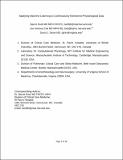| dc.contributor.author | Rush, Barret | |
| dc.contributor.author | Celi, Leo A | |
| dc.contributor.author | Stone, David J | |
| dc.date.accessioned | 2021-09-20T17:30:10Z | |
| dc.date.available | 2021-09-20T17:30:10Z | |
| dc.date.issued | 2018-11-11 | |
| dc.identifier.uri | https://hdl.handle.net/1721.1/131763 | |
| dc.description.abstract | Abstract
The use of machine learning (ML) in healthcare has enormous potential for improving disease detection, clinical decision support, and workflow efficiencies. In this commentary, we review published and potential applications for the use of ML for monitoring within the hospital environment. We present use cases as well as several questions regarding the application of ML to the analysis of the vast amount of complex data that clinicians must interpret in the realm of continuous physiological monitoring. ML, especially employed in bidirectional conjunction with electronic health record data, has the potential to extract much more useful information out of this currently under-analyzed data source from a population level. As a data driven entity, ML is dependent on copious, high quality input data so that error can be introduced by low quality data sources. At present, while ML is being studied in hybrid formulations along with static expert systems for monitoring applications, it is not yet actively incorporated in the formal artificial learning sense of an algorithm constantly learning and updating its rules without external intervention. Finally, innovations in monitoring, including those supported by ML, will pose regulatory and medico-legal challenges, as well as questions regarding precisely how to incorporate these features into clinical care and medical education. Rigorous evaluation of ML techniques compared to traditional methods or other AI methods will be required to validate the algorithms developed with consideration of database limitations and potential learning errors. Demonstration of value on processes and outcomes will be necessary to support the use of ML as a feature in monitoring system development: Future research is needed to evaluate all AI based programs before clinical implementation in non-research settings. | en_US |
| dc.publisher | Springer Netherlands | en_US |
| dc.relation.isversionof | https://doi.org/10.1007/s10877-018-0219-z | en_US |
| dc.rights | Article is made available in accordance with the publisher's policy and may be subject to US copyright law. Please refer to the publisher's site for terms of use. | en_US |
| dc.source | Springer Netherlands | en_US |
| dc.title | Applying machine learning to continuously monitored physiological data | en_US |
| dc.type | Article | en_US |
| dc.contributor.department | Harvard--MIT Program in Health Sciences and Technology. Laboratory for Computational Physiology | |
| dc.eprint.version | Author's final manuscript | en_US |
| dc.type.uri | http://purl.org/eprint/type/JournalArticle | en_US |
| eprint.status | http://purl.org/eprint/status/PeerReviewed | en_US |
| dc.date.updated | 2020-09-24T20:36:39Z | |
| dc.language.rfc3066 | en | |
| dc.rights.holder | Springer Nature B.V. | |
| dspace.embargo.terms | Y | |
| dspace.date.submission | 2020-09-24T20:36:39Z | |
| mit.license | PUBLISHER_POLICY | |
| mit.metadata.status | Authority Work and Publication Information Needed | |
